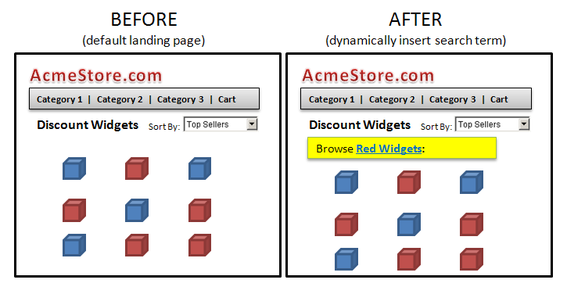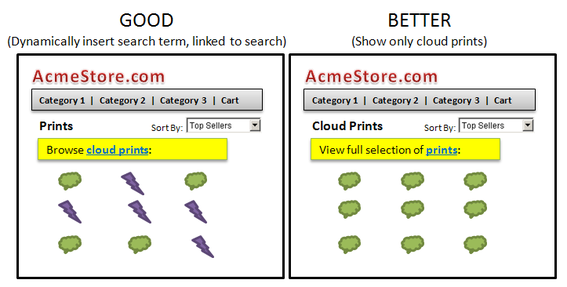The difference between a profitable and an unprofitable pay-per-click advertising campaign can be the post-click conversion rate. We’ve run hundreds of conversion rate optimization tests at my firm over the past decade. Below I’ll share five optimizations that have consistently driven conversion rates higher.
1. Keyword Above the Fold
Most PPC managers know that you can boost click through rates by dynamically inserting the keyword a shopper searched for into their ads. We’ve taken that one step further by evaluating the impact of including that same keyword prominently on the page shoppers find after clicking an ad.
The results of including the searched-on keyword in the landing page have been compelling. We’ve consistently observed lower bounce rates and higher conversion rates of up to 20 percent
One way you can include the searched-on keyword is by implementing a simple script that reads the keyword the shopper used to find your site, and dynamically inserts it into your landing page. Your landing page may look like this as a result, if a shopper searched for “red qidgets.”
Echo whatever search term the shopper used to find your site. The example on the right repeats the search term "red widgets."
You can dynamically link the keyword so that when it is clicked, a search is automatically performed on your site. That way, if users do not find the results on your page to be as relevant as possible — i.e., they wanted red widgets but the selection offers widgets of all colors, as is the case in the example above — they have an easy way to perform a quick search on your site.
Another approach, one that can have search engine optimization benefits as well, is to insert the keywords that drive traffic to a particular landing page both naturally and through paid search campaigns, and ensuring that your above-the-fold content and merchandising assortment is as relevant to those keywords as possible.
2. Feature Relevant Products
A basic rule of pay-per-click advertising is to bring shoppers who click on your ad to a relevant page on your site that matches their intent. Many online merchants do this pretty well, but in my experience there is a lot of room for improvement.
For example, if there is a lot of search activity for the phrase “cloud prints,” and also for the related phrase “lightening prints,” and today you have a single landing page promoting both, consider giving each a unique landing page.
We’ve ran tests related to that scenario, and found that conversion rates are significantly higher when the product mix displayed on the landing page immediately matches the shopper’s search query, rather than requiring them to use sorting and filtering tools.
Match the content of the landing page to the shopper’s search query. The example on the right shows results only for "cloud print," the shopper’s search term.
3. Strategically Set Default ‘Sort by’ Settings
We’ve found that the default sort preference for your landing pages can have a big impact on average order value and conversion rates.
Sorting from highest price to lowest price, for example, often results in a higher average order value. However, sorting from lowest price to highest price may result in a higher conversion rate. According to our tests, increased revenue due to the higher average order value typically compensates for the lower conversion rate, making it a net positive.
Conduct conversion tests on your own website to find the optimal recipe. When you run your tests, make sure to segment them to treat shoppers who arrive at a landing page immediately after conducting a search on a search engine differently than a shopper who browses to a landing page from somewhere else on your site.
4. Speed Matters
Now that Google factors site speed into its natural search algorithm, online retailers have been busy trying to improve load times. We’ve spent years testing various approaches to improving site speed while measuring its impact on conversions. We recently tested site speed and conversions for a large merchant. It yielded impressive results, as follows:
- Site-wide conversion rate increase: 9 percent;
- Overall revenue increase: 13 percent.
By improving your site’s load time, you can boost your conversion rate, which gives you an advantage over your pay-per-click competitors. As a result, you can profitably bid more per click.
The site speed test above reduced the load time of key pages, such as the home page, from 10.383 seconds to 2.757. To achieve this, we went beyond standard best practices, like implementing a content delivery network. We learned that true site speed optimization requires uniquely transforming a site’s code to accommodate each web browser uniquely. We also learned the importance of using analytics to pre-load site and cart pages before shoppers browse to them.
5. Optimize Button Text and Colors
Small changes — like optimizing buttons — can add up to big conversion rate improvements.
For example, we’ve conducted conversion tests that resulted in product page conversion rates increasing up to 35 percent by simply changing the “Add to Cart” button from one color to another. The optimal color usually has the greatest contrast with the other colors on the page.
We’ve also learned, repeatedly, that being too creative can kill conversion rates. For example, many merchants get creative with their site-wide link to the shopping cart. They use language such as “Shopping Bag,” “View My Bag,” and “Cart.” We’ve tested many different ways to describe the shopping cart link, and “View Cart” usually wins. That lesson applies similarly to the “Add to Cart” button, where “Add to Cart” consistently performs better than clever variations that simply confuse shoppers.
While every merchant who is serious about increasing conversion rates should have an ongoing, well-structured conversion rate testing initiative, many conversion rate improvements use the following common sense principles.
- Make important buttons stand out with high-contrast colors.
- Label them as simply as possible.
- Don’t have too many buttons clustered close together.
- Conventions can be your friend.
Conclusion
Lower bounce rates and higher conversion rates not only make your pay-per-click program more profitable, they enable you to scale your campaigns faster. When you combine higher conversion rates with post-purchase email marketing that increases the lifetime value of each customer, you can confidently outbid your competitors and grow your business faster and more profitably.




